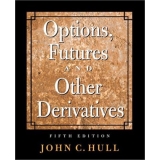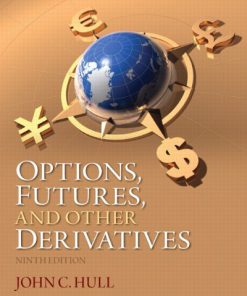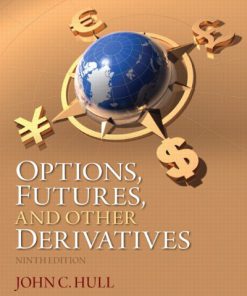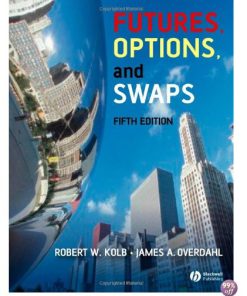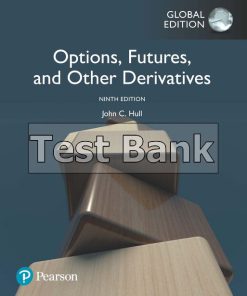Test Bank for (Chapter 1 – 26) Options Futures and Other Derivatives 10th Edition John C. Hull
$35.00 Original price was: $35.00.$26.50Current price is: $26.50.
Test Bank for (Chapter 1 – 26) Options Futures and Other Derivatives 10th Edition John C. Hull,
This is completed downloadable of Test Bank for (Chapter 1 – 26) Options Futures and Other Derivatives 10th Edition John C. Hull

Product Details:
- ISBN-10 : 013447208X
- ISBN-13 : 978-0134472089
- Author: John Hull
Known as “the bible” to business and economics professionals and a consistent best-seller, Options, Futures, and Other Derivatives gives readers a modern look at derivatives markets. By incorporating the industry’s hottest topics, such as the securitization and credit crisis, author John C. Hull helps bridge the gap between theory and practice. The 10th Edition covers all of the latest regulations and trends, including the Black-Scholes-Merton formulas, overnight indexed swaps, and the valuation of commodity derivatives.
Table of Content:
- Options, Futures, and Other Derivatives
- Options, Futures, and Other Derivatives
- Contents In Brief
- Contents
- BUSINESS SNAPSHOTS
- TECHNICAL NOTES
- Preface
- What’s New in the Tenth Edition?
- Software
- Slides
- Solutions Manual
- Instructors Manual
- Technical Notes
- About the Author
- Chapter 1 Introduction
- 1.1 EXCHANGE-TRADED MARKETS
- Electronic Markets
- 1.2 OVER-THE-COUNTER MARKETS
- Market Size
- 1.3 FORWARD CONTRACTS
- Payoffs from Forward Contracts
- Forward Prices and Spot Prices
- 1.4 FUTURES CONTRACTS
- 1.5 OPTIONS
- 1.6 TYPES OF TRADERS
- 1.7 HEDGERS
- Hedging Using Forward Contracts
- Hedging Using Options
- A Comparison
- 1.8 SPECULATORS
- Speculation Using Futures
- Speculation Using Options
- A Comparison
- 1.9 ARBITRAGEURS
- 1.10 DANGERS
- Summary
- Further Reading
- Practice Questions (Answers in Solutions Manual)
- Further Questions
- 1.1 EXCHANGE-TRADED MARKETS
- Chapter 2 Futures Markets and Central Counterparties
- 2.1 BACKGROUND
- Closing Out Positions
- 2.2 SPECIFICATION OF A FUTURES CONTRACT
- The Asset
- The Contract Size
- Delivery Arrangements
- Delivery Months
- Price Quotes
- Price Limits and Position Limits
- 2.3 CONVERGENCE OF FUTURES PRICE TO SPOT PRICE
- 2.4 THE OPERATION OF MARGIN ACCOUNTS
- Daily Settlement
- Further Details
- The Clearing House and Its Members
- Credit Risk
- 2.5 OTC MARKETS
- Central Counterparties
- Bilateral Clearing
- Futures Trades vs. OTC Trades
- 2.6 MARKET QUOTES
- Prices
- Settlement Price
- Trading Volume and Open Interest
- Patterns of Futures
- 2.7 DELIVERY
- Cash Settlement
- 2.8 TYPES OF TRADERS AND TYPES OF ORDERS
- Orders
- 2.9 REGULATION
- Trading Irregularities
- 2.10 ACCOUNTING AND TAX
- Accounting
- Tax
- 2.11 FORWARD vs. FUTURES CONTRACTS
- Profits from Forward and Futures Contracts
- Foreign Exchange Quotes
- Summary
- Further Reading
- Practice Questions (Answers in Solutions Manual)
- Further Questions
- 2.1 BACKGROUND
- Chapter 3 Hedging Strategies Using Futures
- 3.1 BASIC PRINCIPLES
- Short Hedges
- Long Hedges
- 3.2 ARGUMENTS FOR AND AGAINST HEDGING
- Hedging and Shareholders
- Hedging and Competitors
- Hedging Can Lead to a Worse Outcome
- 3.3 BASIS RISK
- The Basis
- Choice of Contract
- 3.4 CROSS HEDGING
- Calculating the Minimum Variance Hedge Ratio
- Optimal Number of Contracts
- Impact of Daily Settlement
- 3.5 STOCK INDEX FUTURES
- Stock Indices
- Hedging an Equity Portfolio
- Reasons for Hedging an Equity Portfolio
- Changing the Beta of a Portfolio
- Locking in the Benefits of Stock Picking
- 3.6 STACK AND ROLL
- Summary
- Further Reading
- Practice Questions (Answers in Solutions Manual)
- Further Questions
- APPENDIX CAPITAL ASSET PRICING MODEL
- 3.1 BASIC PRINCIPLES
- Chapter 4 Interest Rates
- 4.1 TYPES OF RATES
- Treasury Rates
- LIBOR
- Overnight Rates
- Repo Rates
- 4.2 SWAP RATES
- Overnight Indexed Swaps
- 4.3 THE RISK-FREE RATE
- 4.4 MEASURING INTEREST RATES
- Continuous Compounding
- 4.5 ZERO RATES
- 4.6 BOND PRICING
- Bond Yield
- Par Yield
- 4.7 DETERMINING ZERO RATES
- Treasury Rates
- OIS Rates
- 4.8 FORWARD RATES
- 4.9 FORWARD RATE AGREEMENTS
- Valuation
- 4.10 DURATION
- Modified Duration
- Bond Portfolios
- 4.11 CONVEXITY
- 4.12 THEORIES OF THE TERM STRUCTURE OF INTEREST RATES
- The Management of Net Interest Income
- Liquidity
- Summary
- Further Reading
- Practice Questions (Answers in Solutions Manual)
- Further Questions
- 4.1 TYPES OF RATES
- Chapter 5 Determination of Forward and Futures Prices
- 5.1 INVESTMENT ASSETS VS. CONSUMPTION ASSETS
- 5.2 SHORT SELLING
- 5.3 ASSUMPTIONS AND NOTATION
- 5.4 FORWARD PRICE FOR AN INVESTMENT ASSET
- A Generalization
- What If Short Sales Are Not Possible?
- 5.5 KNOWN INCOME
- A Generalization
- 5.6 KNOWN YIELD
- 5.7 VALUING FORWARD CONTRACTS
- 5.8 ARE FORWARD PRICES AND FUTURES PRICES EQUAL?
- 5.9 FUTURES PRICES OF STOCK INDICES
- Index Arbitrage
- 5.10 FORWARD AND FUTURES CONTRACTS ON CURRENCIES
- A Foreign Currency as an Asset Providing a Known Yield
- 5.11 FUTURES ON COMMODITIES
- Income and Storage Costs
- Consumption Commodities
- Convenience Yields
- 5.12 THE COST OF CARRY
- 5.13 DELIVERY OPTIONS
- 5.14 FUTURES PRICES AND EXPECTED FUTURE SPOT PRICES
- Keynes and Hicks
- Risk and Return
- The Risk in a Futures Position
- Normal Backwardation and Contango
- Summary
- Further Reading
- Practice Questions (Answers in Solutions Manual)
- Further Questions
- Chapter 6 Interest Rate Futures
- 6.1 DAY COUNT AND QUOTATION CONVENTIONS
- Day Counts
- Price Quotations of U.S. Treasury Bills
- Price Quotations of U.S. Treasury Bonds
- 6.2 TREASURY BOND FUTURES
- Quotes
- Conversion Factors
- Cheapest-to-Deliver Bond
- Determining the Futures Price
- 6.3 EURODOLLAR FUTURES
- Forward vs. Futures Interest Rates
- Convexity Adjustment
- Using Eurodollar Futures to Extend the LIBOR Zero Curve
- 6.4 DURATION-BASED HEDGING STRATEGIES USING FUTURES
- 6.5 HEDGING PORTFOLIOS OF ASSETS AND LIABILITIES
- Summary
- Further Reading
- Practice Questions (Answers in Solutions Manual)
- Further Questions
- 6.1 DAY COUNT AND QUOTATION CONVENTIONS
- Chapter 7 Swaps
- 7.1 MECHANICS OF INTEREST RATE SWAPS
- LIBOR
- Illustration
- Using the Swap to Transform a Liability
- Using the Swap to Transform an Asset
- Organization of Trading
- 7.2 DAY COUNT ISSUES
- 7.3 CONFIRMATIONS
- 7.4 THE COMPARATIVE-ADVANTAGE ARGUMENT
- Illustration
- Criticism of the Comparative-Advantage Argument
- 7.5 VALUATION OF INTEREST RATE SWAPS
- Bootstrapping LIBOR Forward Rates
- 7.6 HOW THE VALUE CHANGES THROUGH TIME
- 7.7 FIXED-FOR-FIXED CURRENCY SWAPS
- Illustration
- Use of a Currency Swap to Transform Liabilities and Assets
- Comparative Advantage
- 7.8 VALUATION OF FIXED-FOR-FIXED CURRENCY SWAPS
- Valuation in Terms of Bond Prices
- 7.9 OTHER CURRENCY SWAPS
- 7.10 CREDIT RISK
- 7.11 CREDIT DEFAULT SWAPS
- 7.12 OTHER TYPES OF SWAPS
- Variations on the Standard Interest Rate Swap
- Quantos
- Equity Swaps
- Options
- Commodity, Volatility, and Other Swaps
- Summary
- Further Reading
- Practice Questions (Answers in Solutions Manual)
- Further Questions
- 7.1 MECHANICS OF INTEREST RATE SWAPS
- Chapter 8 Securitization and the Credit Crisis of 2007
- 8.1 SECURITIZATION
- ABSs
- ABS CDOs
- 8.2 THE U.S. HOUSING MARKET
- The Relaxation of Lending Standards
- Subprime Mortgage Securitization
- The Bubble Bursts
- The Losses
- The Credit Crisis
- 8.3 WHAT WENT WRONG?
- Regulatory Arbitrage
- Incentives
- 8.4 THE AFTERMATH
- Summary
- Further Reading
- Practice Questions (Answers in Solutions Manual)
- Further Questions
- 8.1 SECURITIZATION
- Chapter 9 XVAs
- 9.1 CVA AND DVA
- Collateral
- 9.2 FVA AND MVA
- 9.3 KVA
- 9.4 CALCULATION ISSUES
- Summary
- Further Reading
- Practice Questions (Answers in Solutions Manual)
- Further Questions
- 9.1 CVA AND DVA
- Chapter 10 Mechanics of Options Markets
- 10.1 TYPES OF OPTIONS
- Call Options
- Put Options
- Early Exercise
- 10.2 OPTION POSITIONS
- 10.3 UNDERLYING ASSETS
- Stock Options
- ETP Options
- Foreign Currency Options
- Index Options
- Futures Options
- 10.4 SPECIFICATION OF STOCK OPTIONS
- Expiration Dates
- Strike Prices
- Terminology
- FLEX Options
- Other Nonstandard Products
- Dividends and Stock Splits
- Position Limits and Exercise Limits
- 10.5 TRADING
- Market Makers
- Offsetting Orders
- 10.6 COMMISSIONS
- 10.7 MARGIN REQUIREMENTS
- Writing Naked Options
- Other Rules
- 10.8 THE OPTIONS CLEARING CORPORATION
- Exercising an Option
- 10.9 REGULATION
- 10.10 TAXATION
- Wash Sale Rule
- Constructive Sales
- 10.11 WARRANTS, EMPLOYEE STOCK OPTIONS, AND CONVERTIBLES
- 10.12 OVER-THE-COUNTER OPTIONS MARKETS
- Summary
- Further Reading
- Practice Questions (Answers in Solutions Manual)
- Further Questions
- 10.1 TYPES OF OPTIONS
- Chapter 11 Properties of Stock Options
- 11.1 Factors Affecting Option Prices
- Stock Price and Strike Price
- Time to Expiration
- Volatility
- Risk-Free Interest Rate
- Amount of Future Dividends
- 11.2 ASSUMPTIONS AND NOTATION
- 11.3 UPPER AND LOWER BOUNDS FOR OPTION PRICES
- Upper Bounds
- Lower Bound for Calls on Non-Dividend-Paying Stocks
- Lower Bound for European Puts on Non-Dividend-Paying Stocks
- 11.4 PUT–CALL PARITY
- American Options
- 11.5 CALLS ON A NON-DIVIDEND-PAYING STOCK
- Bounds
- 11.6 PUTS ON A NON-DIVIDEND-PAYING STOCK
- Bounds
- 11.7 EFFECT OF DIVIDENDS
- Lower Bound for Calls and Puts
- Early Exercise
- Put–Call Parity
- Summary
- Further Reading
- Practice Questions (Answers in Solutions Manual)
- Further Questions
- 11.1 Factors Affecting Option Prices
- Chapter 12 Trading Strategies Involving Options
- 12.1 PRINCIPAL-PROTECTED NOTES
- 12.2 TRADING AN OPTION AND THE UNDERLYING ASSET
- 12.3 SPREADS
- Bull Spreads
- Bear Spreads
- Box Spreads
- Butterfly Spreads
- Calendar Spreads
- Diagonal Spreads
- 12.4 COMBINATIONS
- Straddle
- Strips and Straps
- Strangles
- 12.5 OTHER PAYOFFS
- Summary
- Further Reading
- Practice Questions (Answers in Solutions Manual)
- Further Questions
- Chapter 13 Binomial Trees
- 13.1 A ONE-STEP BINOMIAL MODEL AND A NO-ARBITRAGE ARGUMENT
- A Generalization
- Irrelevance of the Stock’s Expected Return
- 13.2 RISK-NEUTRAL VALUATION
- The One-Step Binomial Example Revisited
- Real World vs. Risk-Neutral World
- 13.3 TWO-STEP BINOMIAL TREES
- A Generalization
- 13.4 A PUT EXAMPLE
- 13.5 AMERICAN OPTIONS
- 13.6 DELTA
- 13.7 MATCHING VOLATILITY WITH u AND d
- Girsanov’s Theorem
- 13.8 THE BINOMIAL TREE FORMULAS
- 13.9 INCREASING THE NUMBER OF STEPS
- 13.10 USING DerivaGem
- 13.11 OPTIONS ON OTHER ASSETS
- Options on Stocks Paying a Continuous Dividend Yield
- Options on Stock Indices
- Options on Currencies
- Options on Futures
- Summary
- Further Reading
- Practice Questions (Answers in Solutions Manual)
- Further Questions
- APPENDIX DERIVATION OF THE BLACK–SCHOLES–MERTON OPTION-PRICING FORMULA FROM A BINOMIAL TREE
- 13.1 A ONE-STEP BINOMIAL MODEL AND A NO-ARBITRAGE ARGUMENT
- Chapter 14 Wiener Processes and Itô’s Lemma
- 14.1 THE MARKOV PROPERTY
- 14.2 CONTINUOUS-TIME STOCHASTIC PROCESSES
- Wiener Process
- Generalized Wiener Process
- Itô Process
- 14.3 THE PROCESS FOR A STOCK PRICE
- Discrete-Time Model
- Monte Carlo Simulation
- 14.4 THE PARAMETERS
- 14.5 CORRELATED PROCESSES
- 14.6 ITÔ’S LEMMA
- Application to Forward Contracts
- 14.7 THE LOGNORMAL PROPERTY
- Summary
- Further Reading
- Practice Questions (Answers in Solutions Manual)
- Further Questions
- APPENDIX A NONRIGOROUS DERIVATION OF ITô’S LEMMA
- Chapter 15 The Black–Scholes–Merton Model
- 15.1 LOGNORMAL PROPERTY OF STOCK PRICES
- 15.2 THE DISTRIBUTION OF THE RATE OF RETURN
- 15.3 THE EXPECTED RETURN
- 15.4 VOLATILITY
- Estimating Volatility from Historical Data
- Trading Days vs. Calendar Days
- 15.5 THE IDEA UNDERLYING THE BLACK–SCHOLES–MERTON DIFFERENTIAL EQUATION
- Assumptions
- 15.6 DERIVATION OF THE BLACK–SCHOLES–MERTON DIFFERENTIAL EQUATION
- A Perpetual Derivative
- The Prices of Tradeable Derivatives
- 15.7 RISK-NEUTRAL VALUATION
- Application to Forward Contracts on a Stock
- 15.8 BLACK–SCHOLES–MERTON PRICING FORMULAS
- Understanding N(d1) and N(d2)
- Properties of the Black–Scholes–Merton Formulas
- 15.9 CUMULATIVE NORMAL DISTRIBUTION FUNCTION
- 15.10 WARRANTS AND EMPLOYEE STOCK OPTIONS
- 15.11 IMPLIED VOLATILITIES
- The VIX Index
- 15.12 DIVIDENDS
- European Options
- American Call Options
- Black’s Approximation
- Summary
- Further Reading
- Practice Questions (Answers in Solutions Manual)
- Further Questions
- APPENDIX PROOF OF THE BLACK–SCHOLES–MERTON FORMULA USING RISK-NEUTRAL VALUATION
- Key Result
- Proof of Key Result
- The Black–Scholes–Merton Result
- Chapter 16 Employee Stock Options
- 16.1 CONTRACTUAL ARRANGEMENTS
- The Early Exercise Decision
- 16.2 DO OPTIONS ALIGN THE INTERESTS OF SHAREHOLDERS AND MANAGERS?
- 16.3 ACCOUNTING ISSUES
- Alternatives to Stock Options
- 16.4 VALUATION
- The “Quick and Dirty” Approach
- Binomial Tree Approach
- The Exercise Multiple Approach
- A Market-Based Approach
- Dilution
- 16.5 BACKDATING SCANDALS
- Summary
- Further Reading
- Practice Questions (Answers in Solutions Manual)
- Further Questions
- 16.1 CONTRACTUAL ARRANGEMENTS
- Chapter 17 Options on Stock Indices and Currencies
- 17.1 OPTIONS ON STOCK INDICES
- Portfolio Insurance
- When the Portfolio’s Beta Is Not 1.0
- 17.2 CURRENCY OPTIONS
- Range Forwards
- 17.3 OPTIONS ON STOCKS PAYING KNOWN DIVIDEND YIELDS
- Lower Bounds for Option Prices
- Put–Call Parity
- Pricing Formulas
- Differential Equation and Risk-Neutral Valuation
- 17.4 VALUATION OF EUROPEAN STOCK INDEX OPTIONS
- Forward Prices
- Implied Dividend Yields
- 17.5 VALUATION OF EUROPEAN CURRENCY OPTIONS
- Using Forward Exchange Rates
- 17.6 AMERICAN OPTIONS
- Summary
- Further Reading
- Practice Questions (Answers in Solutions Manual)
- Further Questions
- 17.1 OPTIONS ON STOCK INDICES
- Chapter 18 Futures Options and Black’s Model
- 18.1 NATURE OF FUTURES OPTIONS
- Expiration Months
- Options on Interest Rate Futures
- 18.2 REASONS FOR THE POPULARITY OF FUTURES OPTIONS
- 18.3 EUROPEAN SPOT AND FUTURES OPTIONS
- 18.4 PUT–CALL PARITY
- 18.5 BOUNDS FOR FUTURES OPTIONS
- 18.6 DRIFT OF A FUTURES PRICE IN A RISK-NEUTRAL WORLD
- Differential Equation
- 18.7 BLACK’S MODEL FOR VALUING FUTURES OPTIONS
- 18.8 USING BLACK’S MODEL INSTEAD OF BLACK–SCHOLES–MERTON
- 18.9 VALUATION OF FUTURES OPTIONS USING BINOMIAL TREES
- A Generalization
- Multistep Trees
- 18.10 AMERICAN FUTURES OPTIONS vs. AMERICAN SPOT OPTIONS
- 18.11 FUTURES-STYLE OPTIONS
- Summary
- Further Reading
- Practice Questions (Answers in Solutions Manual)
- Further Questions
- 18.1 NATURE OF FUTURES OPTIONS
- Chapter 19 The Greek Letters
- 19.1 ILLUSTRATION
- 19.2 NAKED AND COVERED POSITIONS
- A Stop-Loss Strategy
- 19.3 GREEK LETTER CALCULATION
- 19.4 DELTA HEDGING
- Delta of European Stock Options
- Dynamic Aspects of Delta Hedging
- Where the Cost Comes From
- Delta of a Portfolio
- Transaction Costs
- 19.5 THETA
- 19.6 GAMMA
- Making a Portfolio Gamma Neutral
- Calculation of Gamma
- 19.7 RELATIONSHIP BETWEEN DELTA, THETA, AND GAMMA
- 19.8 VEGA
- 19.9 RHO
- 19.10 THE REALITIES OF HEDGING
- 19.11 SCENARIO ANALYSIS
- 19.12 EXTENSION OF FORMULAS
- Delta of Forward Contracts
- Delta of a Futures Contract
- 19.13 PORTFOLIO INSURANCE
- Use of Index Futures
- 19.14 STOCK MARKET VOLATILITY
- Summary
- Further Reading
- Practice Questions (Answers in Solutions Manual)
- Further Questions
- APPENDIX TAYLOR SERIES EXPANSIONS AND GREEK LETTERS
- The Practitioner Black–Scholes Model
- Chapter 20 Volatility Smiles
- 20.1 WHY THE VOLATILITY SMILE IS THE SAME FOR CALLS AND PUTS
- 20.2 FOREIGN CURRENCY OPTIONS
- Empirical Results
- Reasons for the Smile in Foreign Currency Options
- Empirical Results
- 20.3 EQUITY OPTIONS
- The Reason for the Smile in Equity Options
- 20.4 ALTERNATIVE WAYS OF CHARACTERIZING THE VOLATILITY SMILE
- 20.5 THE VOLATILITY TERM STRUCTURE AND VOLATILITY SURFACES
- 20.6 MINIMUM VARIANCE DELTA
- 20.7 THE ROLE OF THE MODEL
- 20.8 WHEN A SINGLE LARGE JUMP IS ANTICIPATED
- Summary
- Further Reading
- Practice Questions (Answers in Solutions Manual)
- Further Questions
- APPENDIX DETERMINING IMPLIED RISK-NEUTRAL DISTRIBUTIONS FROM VOLATILITY SMILES
- Chapter 21 Basic Numerical Procedures
- 21.1 BINOMIAL TREES
- Risk-Neutral Valuation
- Determination of p, u, and d
- Tree of Asset Prices
- Working Backward through the Tree
- Expressing the Approach Algebraically
- Estimating Delta and Other Greek Letters
- 21.2 USING THE BINOMIAL TREE FOR OPTIONS ON INDICES, CURRENCIES, AND FUTURES CONTRACTS
- 21.3 BINOMIAL MODEL FOR A DIVIDEND-PAYING STOCK
- Known Dividend Yield
- Known Dollar Dividend
- Control Variate Technique
- 21.4 ALTERNATIVE PROCEDURES FOR CONSTRUCTING TREES
- Trinomial Trees
- 21.5 TIME-DEPENDENT PARAMETERS
- 21.6 MONTE CARLO SIMULATION
- Derivatives Dependent on More than One Market Variable
- Generating the Random Samples from Normal Distributions
- Number of Trials
- Sampling through a Tree
- Calculating the Greek Letters
- Applications
- 21.7 VARIANCE REDUCTION PROCEDURES
- Antithetic Variable Technique
- Control Variate Technique
- Importance Sampling
- Stratified Sampling
- Moment Matching
- Using Quasi-Random Sequences
- 21.8 FINITE DIFFERENCE METHODS
- Implicit Finite Difference Method
- Explicit Finite Difference Method
- Change of Variable
- Relation to Trinomial Tree Approaches
- Other Finite Difference Methods
- Applications of Finite Difference Methods
- Summary
- Further Reading
- Practice Questions (Answers in Solutions Manual)
- Further Questions
- 21.1 BINOMIAL TREES
- Chapter 22 Value at Risk and Expected Shortfall
- 22.1 THE VaR AND ES MEASURES
- The Time Horizon
- 22.2 HISTORICAL SIMULATION
- Illustration: Investment in Four Stock Indices
- Expected Shortfall
- Stressed VaR and Stressed ES
- 22.3 MODEL-BUILDING APPROACH
- Daily Volatilities
- Single-Asset Case
- Two-Asset Case
- The Benefits of Diversification
- ES Calculation
- 22.4 THE LINEAR MODEL
- Correlation and Covariance Matrices
- Handling Interest Rates
- Applications of the Linear Model
- The Linear Model and Options
- 22.5 THE QUADRATIC MODEL
- 22.6 MONTE CARLO SIMULATION
- 22.7 COMPARISON OF APPROACHES
- 22.8 BACK TESTING
- 22.9 PRINCIPAL COMPONENTS ANALYSIS
- Using Principal Components Analysis to Calculate VaR
- Summary
- Further Reading
- Practice Questions (Answers in Solutions Manual)
- Further Questions
- 22.1 THE VaR AND ES MEASURES
- Chapter 23 Estimating Volatilities and Correlations
- 23.1 ESTIMATING VOLATILITY
- Weighting Schemes
- 23.2 THE EXPONENTIALLY WEIGHTED MOVING AVERAGE MODEL
- 23.3 THE GARCH(1,1) MODEL
- The Weights
- Mean Reversion
- 23.4 CHOOSING BETWEEN THE MODELS
- 23.5 MAXIMUM LIKELIHOOD METHODS
- Estimating a Constant Variance
- Estimating EWMA or GARCH (1,1) Parameters
- How Good Is the Model?
- 23.6 USING GARCH(1,1) TO FORECAST FUTURE VOLATILITY
- Volatility Term Structures
- Impact of Volatility Changes
- 23.7 CORRELATIONS
- Consistency Condition for Covariances
- 23.8 APPLICATION OF EWMA TO FOUR-INDEX EXAMPLE
- Summary
- Further Reading
- Practice Questions (Answers in Solutions Manual)
- Further Questions
- 23.1 ESTIMATING VOLATILITY
- Chapter 24 Credit Risk
- 24.1 CREDIT RATINGS
- 24.2 HISTORICAL DEFAULT PROBABILITIES
- Hazard Rates
- 24.3 RECOVERY RATES
- The Dependence of Recovery Rates on Default Rates
- 24.4 ESTIMATING DEFAULT PROBABILITIES FROM BOND YIELD SPREADS
- Matching Bond Prices
- The Risk-Free Rate
- Asset Swap Spreads
- 24.5 COMPARISON OF DEFAULT PROBABILITY ESTIMATES
- Real-World vs. Risk-Neutral Probabilities
- Which Default Probability Estimate Should Be Used?
- 24.6 USING EQUITY PRICES TO ESTIMATE DEFAULT PROBABILITIES
- 24.7 CREDIT RISK IN DERIVATIVES TRANSACTIONS
- CVA and DVA
- Credit Risk Mitigation
- Special Cases
- 24.8 DEFAULT CORRELATION
- The Gaussian Copula Model for Time to Default
- A Factor-Based Correlation Structure
- 24.9 CREDIT VAR
- CreditMetrics
- SUMMARY
- Further Reading
- Practice Questions (Answers in the Solutions Manual)
- Further Questions
- Chapter 25 Credit Derivatives
- 25.1 CREDIT DEFAULT SWAPS
- Credit Default Swaps and Bond Yields
- The Cheapest-to-Deliver Bond
- 25.2 VALUATION OF CREDIT DEFAULT SWAPS
- Marking to Market a CDS
- Estimating Default Probabilities
- Binary Credit Default Swaps
- How Important Is the Recovery Rate?
- 25.3 CREDIT INDICES
- 25.4 THE USE OF FIXED COUPONS
- 25.5 CDS FORWARDS AND OPTIONS
- 25.6 BASKET CREDIT DEFAULT SWAPS
- 25.7 TOTAL RETURN SWAPS
- 25.8 COLLATERALIZED DEBT OBLIGATIONS
- Synthetic CDOs
- Standard Portfolios and Single-Tranche Trading
- 25.9 ROLE OF CORRELATION IN A BASKET CDS AND CDO
- 25.10 VALUATION OF A SYNTHETIC CDO
- Using the Gaussian Copula Model of Time to Default
- Valuation of kth-to-Default CDS
- Implied Correlation
- Valuing Nonstandard Tranches
- 25.11 ALTERNATIVES TO THE STANDARD MARKET MODEL
- Heterogeneous Model
- Other Copulas
- Random Recovery and Factor Loadings
- The Implied Copula Model
- Dynamic Models
- Summary
- Further Reading
- Practice Questions (Answers in Solutions Manual)
- Further Questions
- 25.1 CREDIT DEFAULT SWAPS
- Chapter 26 Exotic Options
- 26.1 PACKAGES
- 26.2 PERPETUAL AMERICAN CALL AND PUT OPTIONS
- 26.3 NONSTANDARD AMERICAN OPTIONS
- 26.4 GAP OPTIONS
- 26.5 FORWARD START OPTIONS
- 26.6 CLIQUET OPTIONS
- 26.7 COMPOUND OPTIONS
- 26.8 CHOOSER OPTIONS
- 26.9 BARRIER OPTIONS
- 26.10 BINARY OPTIONS
- 26.11 LOOKBACK OPTIONS
- 26.12 SHOUT OPTIONS
- 26.13 ASIAN OPTIONS
- 26.14 OPTIONS TO EXCHANGE ONE ASSET FOR ANOTHER
- 26.15 OPTIONS INVOLVING SEVERAL ASSETS
- 26.16 VOLATILITY AND VARIANCE SWAPS
- Valuation of Variance Swap
- Valuation of a Volatility Swap
- The VIX Index
- 26.17 STATIC OPTIONS REPLICATION
- Summary
- Further Reading
- Practice Questions (Answers in Solutions Manual)
- Further Questions
- Chapter 27 More on Models and Numerical Procedures
- 27.1 ALTERNATIVES TO BLACK–SCHOLES–MERTON
- The Constant Elasticity of Variance Model
- Merton’s Mixed Jump–Diffusion Model
- Simulating Jumps
- The Variance-Gamma Model
- 27.2 STOCHASTIC VOLATILITY MODELS
- The SABR Model
- 27.3 THE IVF MODEL
- 27.4 CONVERTIBLE BONDS
- 27.5 PATH-DEPENDENT DERIVATIVES
- 27.6 BARRIER OPTIONS
- 27.7 OPTIONS ON TWO CORRELATED ASSETS
- Transforming Variables
- Using a Nonrectangular Tree
- Adjusting the Probabilities
- 27.8 MONTE CARLO SIMULATION AND AMERICAN OPTIONS
- The Least-Squares Approach
- The Exercise Boundary Parameterization Approach
- Upper Bounds
- Summary
- Further Reading
- Practice Questions (Answers in Solutions Manual)
- Further Questions
- 27.1 ALTERNATIVES TO BLACK–SCHOLES–MERTON
- Chapter 28 Martingales and Measures
- 28.1 THE MARKET PRICE OF RISK
- Alternative Worlds
- 28.2 SEVERAL STATE VARIABLES
- 28.3 MARTINGALES
- The Equivalent Martingale Measure Result
- 28.4 ALTERNATIVE CHOICES FOR THE NUMERAIRE
- Money Market Account as the Numeraire
- Zero-Coupon Bond Price as the Numeraire
- Forward Interest Rates
- Annuity Factor as the Numeraire
- 28.5 EXTENSION TO SEVERAL FACTORS
- 28.6 BLACK’S MODEL REVISITED
- 28.7 OPTION TO EXCHANGE ONE ASSET FOR ANOTHER
- 28.8 CHANGE OF NUMERAIRE
- A Final Point
- Summary
- Further Reading
- Practice Questions (Answers in the Solutions Manual)
- Further Questions
- 28.1 THE MARKET PRICE OF RISK
- Chapter 29 Interest Rate Derivatives: The Standard Market Models
- 29.1 BOND OPTIONS
- Embedded Bond Options
- European Bond Options
- Yield Volatilities
- 29.2 INTEREST RATE CAPS AND FLOORS
- The Cap as a Portfolio of Interest Rate Options
- A Cap as a Portfolio of Bond Options
- Floors and Collars
- Valuation of Caps and Floors
- Theoretical Justification for the Model
- Use of DerivaGem
- The Impact of Day Count Conventions
- Negative Rates
- 29.3 EUROPEAN SWAP OPTIONS
- Valuation of European Swaptions
- Theoretical Justification for the Swaption Model
- The Impact of Day Count Conventions
- Negative Rates
- 29.4 HEDGING INTEREST RATE DERIVATIVES
- Summary
- Further Reading
- Practice Questions (Answers in Solutions Manual)
- Further Questions
- 29.1 BOND OPTIONS
- Chapter 30 Convexity, Timing, and Quanto Adjustments
- 30.1 CONVEXITY ADJUSTMENTS
- Application 1: Interest Rates
- Application 2: Swap Rates
- 30.2 TIMING ADJUSTMENTS
- Application 1 Revisited
- 30.3 QUANTOS
- Using Traditional Risk-Neutral Measures
- Summary
- Further Reading
- Practice Questions (Answers in Solutions Manual)
- Further Questions
- APPENDIX PROOF OF THE CONVEXITY ADJUSTMENT FORMULA
- 30.1 CONVEXITY ADJUSTMENTS
- Chapter 31 Equilibrium Models of the Short Rate
- 31.1 BACKGROUND
- 31.2 ONE-FACTOR MODELS
- The Rendleman and Bartter Model
- The Vasicek Model
- The Cox, Ingersoll, and Ross Model
- Properties of Vasicek and CIR
- The Bond Price Process
- 31.3 REAL-WORLD VS. RISK-NEUTRAL PROCESSES
- 31.4 ESTIMATING PARAMETERS
- 31.5 MORE SOPHISTICATED MODELS
- Summary
- Further Reading
- Practice Questions (Answers in Solutions Manual)
- Further Questions
- Chapter 32 No-Arbitrage Models of the Short Rate
- 32.1 EXTENSIONS OF EQUILIBRIUM MODELS
- The Ho–Lee Model
- The Hull–White One-Factor Model
- The Black–Derman–Toy Model
- The Black–Karasinski Model
- The Hull–White Two-Factor Model
- 32.2 OPTIONS ON BONDS
- Options on Coupon-Bearing Bonds
- 32.3 VOLATILITY STRUCTURES
- 32.4 INTEREST RATE TREES
- Illustration of Use of Trinomial Trees
- Nonstandard Branching
- 32.5 A GENERAL TREE-BUILDING PROCEDURE
- First Stage
- Second Stage
- Illustration of Second Stage
- Formulas for α’s and Q’s
- Extension to Other Models
- Negative Rates
- OIS Discounting
- Using Analytic Results in Conjunction with Trees
- Tree for American Bond Options
- 32.6 CALIBRATION
- 32.7 HEDGING USING A ONE-FACTOR MODEL
- Summary
- Further Reading
- Practice Questions (Answers in Solutions Manual)
- Further Questions
- 32.1 EXTENSIONS OF EQUILIBRIUM MODELS
- Chapter 33 HJM, LMM, and Multiple Zero Curves
- 33.1 THE HEATH, JARROW, AND MORTON MODEL
- Processes for Zero-Coupon Bond Prices and Forward Rates
- Extension to Several Factors
- 33.2 THE LIBOR MARKET MODEL
- The Model
- Forward Rate Volatilities
- Implementation of the Model
- Extension to Several Factors
- Ratchet Caps, Sticky Caps, and Flexi Caps
- Valuing European Swap Options
- Calibrating the Model
- Volatility Skews
- Bermudan Swap Options
- 33.3 HANDLING MULTIPLE ZERO CURVES
- 33.4 AGENCY MORTGAGE-BACKED SECURITIES
- Collateralized Mortgage Obligations
- Valuing Agency Mortgage-Backed Securities
- Option-Adjusted Spread
- Summary
- Further Reading
- Practice Questions (Answers in Solutions Manual)
- Further Questions
- 33.1 THE HEATH, JARROW, AND MORTON MODEL
- Chapter 34 Swaps Revisited
- 34.1 VARIATIONS ON THE VANILLA DEAL
- 34.2 COMPOUNDING SWAPS
- 34.3 CURRENCY SWAPS
- 34.4 MORE COMPLEX SWAPS
- LIBOR-in-Arrears Swap
- CMS and CMT Swaps
- Differential Swaps
- 34.5 EQUITY SWAPS
- 34.6 SWAPS WITH EMBEDDED OPTIONS
- Accrual Swaps
- Cancelable Swap
- Cancelable Compounding Swaps
- 34.7 OTHER SWAPS
- Bizarre Deals
- Summary
- Further Reading
- Practice Questions (Answers in Solutions Manual)
- Further Questions
- Chapter 35 Energy and Commodity Derivatives
- 35.1 AGRICULTURAL COMMODITIES
- 35.2 METALS
- 35.3 ENERGY PRODUCTS
- Crude Oil
- Natural Gas
- Electricity
- 35.4 MODELING COMMODITY PRICES
- A Simple Process
- Mean Reversion
- Interpolation and Seasonality
- Jumps
- Other Models
- 35.5 WEATHER DERIVATIVES
- 35.6 INSURANCE DERIVATIVES
- 35.7 PRICING WEATHER AND INSURANCE DERIVATIVES
- 35.8 HOW AN ENERGY PRODUCER CAN HEDGE RISKS
- Summary
- Further Reading
- Practice Questions (Answers in Solutions Manual)
- Further Questions
- Chapter 36 Real Options
- 36.1 CAPITAL INVESTMENT APPRAISAL
- 36.2 EXTENSION OF THE RISK-NEUTRAL VALUATION FRAMEWORK
- 36.3 ESTIMATING THE MARKET PRICE OF RISK
- 36.4 APPLICATION TO THE VALUATION OF A BUSINESS
- 36.5 EVALUATING OPTIONS IN AN INVESTMENT OPPORTUNITY
- Illustration
- Evaluation with No Embedded Options
- Use of a Tree
- Option to Abandon
- Option to Expand
- Multiple Options
- Several Stochastic Variables
- Summary
- Further Reading
- Practice Questions (Answers in Solutions Manual)
- Further Questions
- Chapter 37 Derivatives Mishaps and What We Can Learn from Them
- 37.1 LESSONS FOR ALL USERS OF DERIVATIVES
- Define Risk Limits
- Take the Risk Limits Seriously
- Do Not Assume You Can Outguess the Market
- Do Not Underestimate the Benefits of Diversification
- Carry out Scenario Analyses and Stress Tests
- 37.2 LESSONS FOR FINANCIAL INSTITUTIONS
- Monitor Traders Carefully
- Separate the Front, Middle, and Back Office
- Do Not Blindly Trust Models
- Be Conservative in Recognizing Inception Profits
- Do Not Sell Clients Inappropriate Products
- Beware of Easy Profits
- Do Not Ignore Liquidity Risk
- Beware When Everyone Is Following the Same Trading Strategy
- Do Not Make Excessive Use of Short-Term Funding for Long-Term Needs
- Market Transparency Is Important
- Manage Incentives
- Never Ignore Risk Management
- 37.3 LESSONS FOR NONFINANCIAL CORPORATIONS
- Make Sure You Fully Understand the Trades You Are Doing
- Make Sure a Hedger Does Not Become a Speculator
- Be Cautious about Making the Treasury Department a Profit Center
- Summary
- Further Reading
- 37.1 LESSONS FOR ALL USERS OF DERIVATIVES
- Glossary of Terms
- DerivaGem Software
- Major Exchanges Trading Futures and Options
- Table for N(x) When x≼0.
- Table for N(x) When x≽0
- Author Index
- Subject Index
People Also Search:
john c hull options futures and other derivatives 10th edition
options futures and other derivatives 10th edition john c. hull
options futures and other derivatives 10th edition john c. hull download scribd
options futures and other derivatives 10th edition john c. hull test bank download pdf
You may also like…
Solution Manual
Solutions Manual to accompany Options, Futures And Other Derivatives 5th edition 9780130090560





